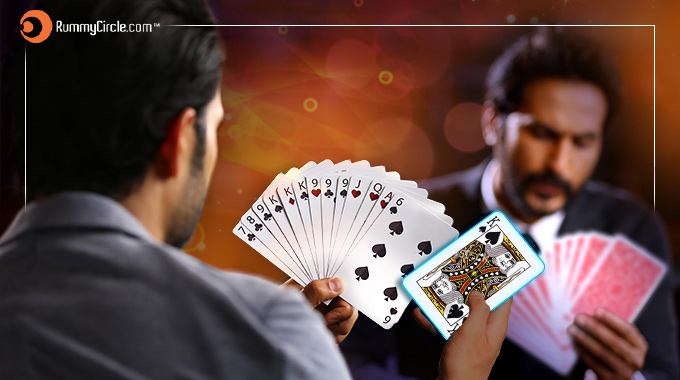Strategy For Beginners : Trick To Discard The Right Cards
Every rummy player will have unwanted cards in hand. The way a player skillfully deals with them is the key to winning the game. There are a couple of tricks to use to your advantage and lower the score. Let us jump right into it and understand the ideal tips to discard the right cards to stay on top of the game.
High-value cards: These cards are Ace, King, Queen, and Jack that carry 10 points each. High-value cards increase your score drastically.
In Indian rummy, the winner’s score is zero, while other players are ranked on their scores respectively, which is the sum of the ungrouped cards. The one with the lowest score is placed at the top of the list and the highest scorer is placed last. If you are playing a cash game, then the person with the lowest score takes home a sizable share of the prize. High-value cards wrecks this opportunity.
Scenario 1: If a player has 13 cards such as J♦ Q♥ K♦ 6♥7♥8♥ 8♠8♣ 4♥4♣4♠ 5♦K♣, then the score will be high in case he loses the game.
Scenario 2: If a player has 13 cards such as J♦ Q♦ K♦ 6♥7♥8♥ 8♠8♣ Q♠4♣4♠ 5♦K♣. In this example, Q is the wildcard joker, so it has zero points. It automatically reduces the score.
There is a good probability that the first thing rummy players are likely to do is discard high-value cards in the initial rounds itself. So, use this to your advantage and switch things up. Retain your high-value cards for now and wait till the third or fourth round to start discarding them. Why, because you can form sequences and sets with cards your fellow players have thrown in the discard pile. If you don’t have a pure sequence yet, here is your opportunity to form it. Isn’t this ingenious!
Middle Cards: These are 4,5, and 6 of all suits and they have value equal to their face value. For example, a player will get 4 points for 4♦. The middle cards also maintain the score from skyrocketing.
It is easier to create sequences with middle cards like 5 and 6 than with high-value cards like Aces. Middle cards such as 5 and 6 offer you alternatives to create sequences with more cards like 3, 4, 7 and 8; something that will restrict you if you have cards like Kings, Queens and Jacks.
Scenario: If a player has 13 cards such as 2♦ 3♥ 4♦6♥7♥8♥8♠8♣4♥4♣4♠5♦K♣, then there are a couple of possibilities that can work.
8♥8♠8♣ – set
3♥4♥6♥7♥– almost a pure sequence. If you get a 5♥, it will complete the sequence. If you pick a 2♥ or 8♥, you will still have a pure sequence.
2♦4♦5♦ – another combination for a sequence. If you pick a 3♦, then it will complete the sequence. If you get a 6♦, you will still have a sequence.
4♣4♠ – a probable set
K♣ – unwanted card
Using idle or unmatched cards to your advantage is a strategy worth learning. It will give you an edge over the other players, if you play yours cards right.




